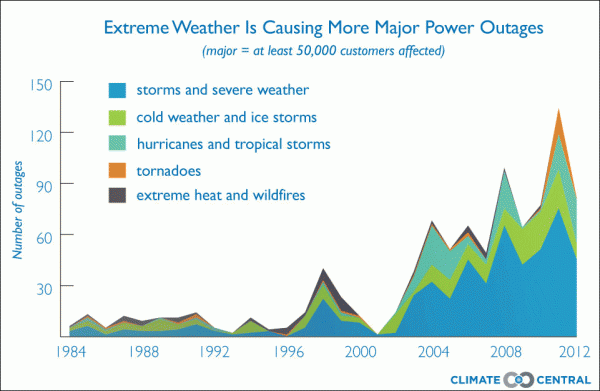Climate Change and the New Normal

One key trend that has emerged over the past 10 years stands out above all others in the context of its impact on the utility industry – in the past decade, weather-related blackouts have doubled thanks in part to climate change. The Earth is currently in an accelerated warming cycle, which is generating a slew of undesirable consequences such as melting glaciers, rising oceans, and destabilizing atmospheric conditions. This is making heat waves hotter, rainfall heavier, and winter storms more intense. We’re also seeing a dramatic increase in the frequency and severity of tornadoes, hurricanes, intense thunderstorms, ice storms, and wildfires.
The Ugly Truth
In April 2014, Climate Central published a report for NERC and the federal government entitled “Blackout: Extreme Weather, Climate Change and Power Outages,” which contained some eye-popping statistics:
- The U.S. has seen a tenfold increase in the number of power outages affecting 50,000 or more customers from 1985-2012.
- The average number of weather-related power outages doubled in the last 10 years, and weather caused 80% of all U.S. outages during this same time.
- It is estimated that 300-500 billion people have experienced a power outage in the last decade.
- Major weather-related outages cost U.S. residents an estimated $20-$55 billion…per year!
The report suggests that three regions of the U.S. are especially vulnerable: the Mid-Atlantic Region, the Midwest, and the Southeastern Region. In the Mid-Atlantic, Pennsylvania and Virginia each experienced the most weather-related outages affecting 50,000 or more customers in the decade analyzed (52), followed by Maryland (50), New York (32), New Jersey (22), West Virginia (22), District of Columbia (16), and Delaware (16). Pennsylvania, Virginia and Maryland had the 4th, 5th and 6th most major outages, respectively, across the entire U.S. during this time.
Overall, the increasing weather volatility, coupled with an aging infrastructure, suggests these trends are not going to change anytime soon. Okay, I know what you’re thinking; it’s a disturbing problem, but what is the solution?
The Remedy
Sorry folks, there is no easy answer here. Much of today’s grid (not to mention natural gas pipelines, water mains, dams, wastewater systems, etc.) looks almost exactly like it did half a century ago, which makes it highly vulnerable. One thing utilities can do is to regularly update and enhance their emergency preparedness program. It isn’t possible to change the reality of the evolving environment within which we operate, so all we can do is strive to continuously adapt and refine our response to it.
Every company we’ve worked with over the years has had their own very specific emergency planning needs, so there is no one-size-fits-all approach. Therefore, it is incumbent on each utility to assess its current plans, processes, and SOPs to identify gaps and improvement opportunities. For example, your emergency plan self-assessment might reveal gaps in your company’s restoration communication process that could be closed by leveraging social media, or that an investment in mobile technology could improve the efficacy of emergency response efforts, or that your company has a process gap when it comes to fuel shortage situations. And there are literally dozens more examples I could give you, but the bottom line is that your emergency preparedness program must evolve over time, so it’s critical to institutionalize some sort of self-audit process that ensures this happens.
The Final Word
If you’ve ever heard the expression, “the trend is your friend,” you know that trends and patterns are important analytical elements when it comes to predicting and planning for an unknown future. It’s clear that we’re in a pattern of increasingly extreme weather thanks to climate change, which, when coupled with a continuously aging infrastructure and increasing demand, will result in more and more major power outages as time goes on. In fact, many scientists are predicting that the hottest days of the year will be at least 10 degrees F warmer by the year 2100 compared to today. Hence, it’s reasonable to assume that the planet’s current warming trend is here to stay. So now more than ever, it’s time for utilities of all shapes and sizes to increase the percentage of resources they allocate to their emergency preparedness efforts.
To read the full Climate Center report, click here.

